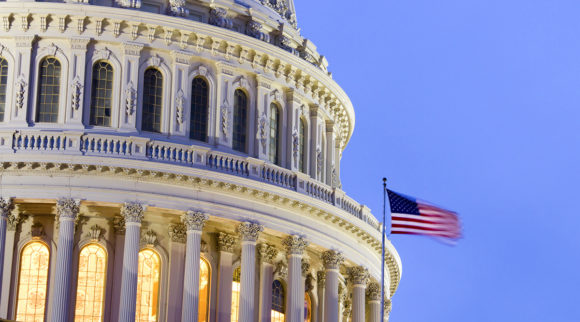Congress is weighing whether insurers and government can together “bend pandemic risk curves” for future events or simply replace some of the economic losses of businesses, putting them “into induced comas” during pandemics.
That was the essence of a debate during a Congressional Virtual Hearing—”Insuring against a Pandemic: Challenges and Solutions for Policyholders and Insurers“—convened to discuss the role of the insurance industry and the federal government in covering pandemic-related losses of small businesses for future pandemics.
During the hearing, which took place five months later than originally planned, participants also debated whether it is too early to propose any solutions at all.
John Doyle, president and chief executive officer of insurance broker Marsh, weighed in on the side of prompt action and in support of risk-based programs that incentivize risk mitigation for future events.
“Although some have suggested that Congress should delay until the current pandemic is over, we feel there are compelling reasons to act now,” he said, referring to the Pandemic Risk Insurance Act (H.R. 7011), a federal government reinsurance backstop modeled after the Terrorism Risk Insurance Act (TRIA) and sponsored by Rep. Carolyn Maloney, (D-NY).

While others highlighted PRIA flaws, including the voluntary nature of the plan that would impact take-up rates, insurer participation and affordability, Doyle focused on the need for speed and risk incentives.
“If we start now, with time and the right solution, we can bend the risk curve for future pandemics,” he said. “Insurance creates the right economic incentives to drive change in society. Moving quickly will help us to harness risk management and to build a more resilient U.S. economy,” he said.
“Taking action now will provide financial protection against future pandemics, in part, by absorbing some of the pandemic’s initial financial shock,” he added.
Doyle said that acting now will “accelerate the economic recovery by reducing uncertainty. Moving forward, he speculated that the “capital markets will seek assurance that companies have protection against prospective pandemic risk.” That means, “the pace of recovery will depend on the nature and degree of confidence in the marketplace,” he said.
But a conservative think tank leader urged Congress to go slow because there are still lessons to be learned from the current pandemic.
“Don’t legislate for the next pandemic while we’re in the midst of the current one. Ad hoc solutions might be as good as it gets. Get help to the businesses, workers and communities who need it right now,” said R.J. Lehmann, senior fellow of the International Center for Law and Economics, and a co-founder of the R Street Institute.
Lehmann consulted with insurance trade groups on a revenue replacement assistance plan known as the Business Continuity Protection Program (BCPP). This plan is being promoted by the American Property Casualty Insurance Association, the National Association of Mutual Insurance Companies and the Independent Insurance Agents & Brokers of America.
Lehmann illustrated his point by noting that one aspect of the plan that he suggested doesn’t seem reasonable just six months later. “A three-month benefit cap was my idea back in April. That seemed generous. It doesn’t look like that now,” he said.

Likewise, he noted that PRIA was originally drafted as a $500 billion program. “It’s now a $750 billion program. Not only is that clearly not enough but giving that it is structured as one pot of money if it were in place during COVID it would all have been eaten up by New York before we got to the second wave or the third wave,” he said.
Lehman also took issue with the idea of a risk-based program. “The best argument for a public-private partnership is that insurers can help policyholders to mitigate risk. But it’s important to ask mitigate the risk of what?” he said. “It’s not the risk that a business is unsafe,” he said, contrasting business interruption and liability insurance lines where pricing signals can help to mitigate risk.
On the liability side, the risk needing to be reduced is the risk that a business will shut down. But in a pandemic, the government wants businesses to shut down. “We want them to have a safety net so that they can shut down and survive and not lobby to lift lockdown orders—because that’s how you get the situation where schools are closed but bars and gyms are open,” Lehmann said.
“Speaking as someone who has long preached the gospel of risk-based insurance, I am telling you that you do not want this to be a risk-based program. A risk-based program would mean that tech firms that can work remotely would pay the least but restaurants, theaters and churches would pay the most. I don’t think that’s the outcome you want,” he said.
Lehmann also noted that while the BCPP specifies that money doled out could only be used for items like payroll and rent, “that’s not how business interruption [insurance] usually works. A business can have an interruption claim and at the same time layoff all its employees,” he said.
A lawmaker asked how typical that scenario is—having a business file a BI claim and then layoff staff.
“That wouldn’t be unusual. [It’s] going to depend on the contract between the insurer and the insured,” Lehmann said, noting that the insurance contract could spell out that it’s insuring payroll. “The government is not involved in that process. And PRIA doesn’t propose anything that would limit that from happening.”
He said what is important are the relationships between employers and employees, businesses and customers.
“The whole goal of PPP was to put all of these businesses into like an induced coma, so that we could tackle the virus, [and] then bring them back and hope everything comes back to normal,” he said, referring to COVID-19 relief loans of the federal government’s Payment Protection Program.
Maloney noted that programs like PRIA and one proposed by Chubb, which combines a risk-based program for larger business and a BCPP-like program for small businesses, center on the idea that pandemic risk is insurable with an appropriate federal backstop.
Yet, she added, some hearing speakers said that pandemic risk is totally not insurable.
A pandemic makes the economic consequences of a pandemic “too severe and beyond the risk-bearing capacity of insurers to ultimately bear,” Doyle said.
Bot Doyle added that Marsh agrees with the view of Chubb’s CEO Evan Greenberg that the industry still has a big role to play nonetheless. “With all due respect, shutting down businesses or putting businesses into a coma is not an ideal future state. We ought to be looking to ultimately change the outcome of the next pandemic,” Doyle said.
Maloney referred to remarks attributed to Chubb’s Greenberg, stating that the “industry does have wherewithal to take risk here” and that it is “a mistake for insurers to think they could not insure this risk at all.”
The task fell to Michelle McLaughlin, chief underwriting officer, Small Business & Commercial Middle Market for Chubb, to explain.
“Chubb believes it is very important for the industry to participate in the solution by playing a risk-bearing role because of the industry’s knowledge and experience can help drive better behaviors,” McLaughlin said. “We really believe the industry needs to have some skin the game here. Our involvement in a public-private partnership with the federal government would lead to a better understanding of pandemic risk and incentivize improved risk mitigation and preparedness,” she said, adding that a program that “commit insurance industry capital also provides an opportunity for increased risk-sharing over time as direct and secondary markets develop,” thereby reducing the government’s future financial burden.
Demand for Coverage
Questions arose about the applicability to pandemics of a federal program like the Terrorism Risk Insurance Act enacted at a time following 9/11 when lenders reacted to carriers putting terrorism exclusions on policies.
Lehman contradicted Doyle’s assertion that capital markets are going to seek assurance that businesses have protection against prospective pandemic risk going forward. “That’s not the situation here,” Lehmann said. “I don’t imagine lenders are going to ask for an insurance product that does not exist.”
Some lawmakers tried to pin down insurance representatives on estimates of pandemic losses and levels of premiums that would be charged under various proposals compared to levels of business interruption premiums today.
Industry representatives offered no guesses.
“It’s hard for me to evaluate proposals to cover future pandemics when no one knows what those premiums might be,” said Rep. Cindy Axne, D-Iowa.
Rep. Trey Hollingsworth, ( R-Ind.), threw cold water on the ideas proposed and even having a subcommittee hearing. Looking into the future, he speculated that even with a program in place, Congress won’t give recoveries to only to businesses that pay into a program, leaving suffering neighbor businesses that didn’t pay in out in the cold.
“The inclination of future Congresses will be to pay everybody, to give everybody a recovery to help spur the economy along. And then no one buys that insurance next round because they’re recognize that everyone got the same payment whether they paid into the program or not.”
“So, I think this whole hearing is about a lot of bad ideas masked under good economic policy, masked under insurance but [they] aren’t actually either,” Hollingworth said.
This is an edited version of an original article from Wells Media’s Carrier Management: Fast Action and Comas: Talking Points At Pandemic Backstop Hearing.
Was this article valuable?
Here are more articles you may enjoy.



 Wildfires, Storms Fuel 2025 Insured Losses of $108 Billion: Munich Re Report
Wildfires, Storms Fuel 2025 Insured Losses of $108 Billion: Munich Re Report  Adjusters Launch ‘CarFax for Insurance Claims’ to Vet Carriers’ Damage Estimates
Adjusters Launch ‘CarFax for Insurance Claims’ to Vet Carriers’ Damage Estimates  Supreme Court Rejects Challenge to $2.46B Boy Scouts Sex Abuse Settlement
Supreme Court Rejects Challenge to $2.46B Boy Scouts Sex Abuse Settlement  SIAA Announces Strategic Partnership With Progressive
SIAA Announces Strategic Partnership With Progressive 


